
Donatello (The Prophet Habakkuk, apprx. 1430).
“If time takes in, space moves out. Space qua place locates; it furnishes outward abode in the world. Space specifies; it gives local habitation.”
Edward S. Casey
“Each time a painter realized that he was dissatisfied with the limited role of painting as a celebration of material property and of the status that accompanies it, he inevitably found himself struggling with the very language of his own art as understood by the tradition of his calling.”
John Berger
“This darkness can be explained by the blind spot in our eye at the point where the optic nerve enters the retina and where we cannot see. Only when the point of the blind spot has been passed do we see the pencil point again as it goes by.”
Ernst Bloch
The model of the theatre is used to explain psychic activity. Jung called it the ‘drama of the psyche’ and Joyce McDougall calls it ‘the theatre of the mind’. Freud, too, used spatial terms to form a topography of the mind. Lacan as well. Both these spaces always resemble the stage, or a staging area. But it is very easy to succumb to radically reductive readings of such models. Benjamin understood the problem of the politics of optics when he wrote…“The Copernican revolution in the conception of history is this: the ‘past’ has been considered the fixed point, the task of the present as that of leading knowledge carefully and hesitantly to this firm ground. Now this relation should be reversed, and the past made into a dialectical fulcrum, to a thought of the awakened consciousness. Politics assumes primacy over history. The facts become something that strikes us now; to determine them becomes a matter of memory. And in fact, awakening is the exemplary case of memory.” So, space and time are both connected to conceptual models that have a political component. And Robert Hullot-Kentor touches on this in his critique of Jameson’s take on Adorno and mimesis.
“Mimesis is the affinity of subject and object as it is felt in one’s knees on seeing someone else stumble on theirs. Yet the disembodied quality of Jameson’s expression, ‘the reader’s mind’, shows no familiarity at all with mimesis. Instead he presupposes the mind as a box at the far end if the nervous system, separate as well from language.”
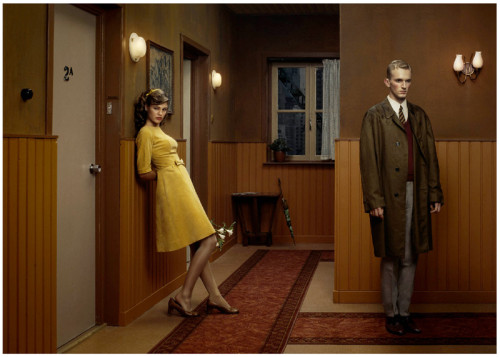
Erwin Olaf, photography.
Now Hullot-Kentor adds that what Jameson misses, and this is exactly the point, is that, using the example of a very dense text say, this dense text, while exasperating, can manage to make its way to that back of our consciousness behind (!) where reading usually takes place, even if not fully *understood*. The experience of not fully understanding is its own kind of understanding. As he also says…“Concepts that cannot be unambiguously defined are to be abandoned as magical after first served for mysterious evocation.” The point is that (and Hullot-Kentor says as much very cogently) that the historical and critical content of language (all languages) is found only (!) in those non-conceptual areas where meaning is coiled (HK) up in certain words, juxtapositions, and form that are unfamiliar and difficult. Here there enters the problem of identity, which per Hullot-Kentor, subordinates object to subject, unless one exhumes a presentation, or expression wherein the object resists its subjective determination. This is an area wherein creativity, imagination, and art can be seen to offer their resistance to domination.
The tyranny of ‘common sense’ is insidious in this respect, for today, increasingly, dialectical thinking is dismissed as magical thinking. When in fact contemporary rationality and science is very much more magical, and not surprisingly is weighted with the ideology of the dominant system. The goal is understand the objects self criticism (self dissatisfaction says Hullot-Kentor) in an effort to move toward what is *not* an idea, and unearth its potentially transformative qualities, ones that can often be radical and disruptive.

Antonello da Messina, (Detail, Virgin Annunciate. Palermo 1476).
It is important to remember that Adorno saw philosophy as having …“no other measure than the collapse of illusion.” For him, memory is always one of suffering. Additionally, and related, Adorno saw in Hegel what he called an ‘identification with the aggressor’. This is the ruse of reason. This has a complex but significant aesthetic aspect. When Hegel sees spirit developing through its otherness, through each stage, as a ‘cry of the ideal’ under domination, Adorno riffs off this as “the gasp of surprise that accompanies the experience of the extraordinary.” This is the transcendence of the unknown in an interrelationship with the known. The gasp is mimetic. Hullot-Kentor writes “the name initiates the distinction of sign and image that is the origin of the explanation and control of nature.” So the subject is a model, or made into a model, or makes itself into a copy of its oppressor, or oppression, but does so through a process of abstracting. Built into science and technics is control, it is a foundational principle.
Mimesis as adaptation however is tied to fear, and by extension via that fear, to death. The paralysis of the body, at some point in the development of the self, was the price that was paid — the inorganic was incorporated into a defensive system. Self preservation is always in a tension with subordination. The total surrender is, if you follow Freud, the death instinct. There are a range of factors, here. Roger Caillois sees the unified consciousness giving way to space, as an inevitable adjustment to the processing of natural space. And there is pleasure in surrender — almost a primordial masochism tied to safety. And all of these actions contain their opposite. Surrender as anxiety, the instinct for escape. The development of an idea of containment, and surrender is also regression. At what point do repeated adaptations become expressions, representations? As Gebauer and Wolf say, the final separation of man from nature only occurs with science. This is rationality, and with that development toward the Enlightenment, subjugation is now delegated to man himself.
“Man’s domination over himself, which grounds his selfhood, is almost always the destruction of the subject in whose service it is undertaken.”
Adorno and Horkheimer
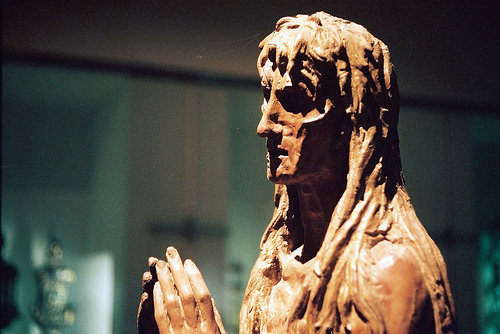
Donatello. (‘The Penitent Magdalene, 1453)
Adorno later, in a mini essay which was never published (left out of Minima Moralia), he touches on some of these implications for Marxist theory:
“Those schooled in dialectical theory are reluctant to indulge in positive images of the proper society, of its members, even of those who would accomplish it…The leap into the future, clean over the conditions of the present, lands in the past. In other words: ends and means cannot be formulated in isolation from each other. Dialectics will have no truck with the maxim that the former justify the latter, no matter how close it seems to come to the doctrine of the ruse of reason or, for that matter, the subordination of individual spontaneity to party discipline. The belief that the blind play of means could be summarily displaced by the sovereignty of rational ends was bourgeois utopianism. It is the antithesis of means and ends itself that should be criticized.”
(New Left Review, July/Aug. 1993)
And this is, in a highly dense explanation, why I think art is radical and revolutionary in the end. But it is in this highly dialectical form that one can understand what negation means for Adorno, and identity. For myth in Adorno’s view is never static (political optics) but repetitive and changing, evolving. Myth is historical, and history is mythical (Hullot-Kentor). Adorno, in his last few years was highly discouraged by what he perceived as ‘pseudo activities’, political theatre. And the inability to distinguish political pseudo activity from material organizing can be seen in symptomatic form in an inability to distinguish the difference between Fassbinder and Darrren Aronovsky, or Pasolini from David Lynch.
Art is only able to destroy illusion by means of illusion. Illusion collapses at that moment of illusory completion. The artwork is then, only an artwork, when it recognizes its own illusions. This goes back to the self criticism of the object.

John Schott, photography.
All this is relevant in the context of contemporary aesthetics (and staging and theatrical metaphors, but I’ll get to that). Adorno, following Hullot-Kentor for just a moment more, criticized polemical art because it eliminated the illusory. Hence, as I’ve said before, message based art ends up being the more reactionary — it becomes opposite of its intention. The imprint of domination is indelible because of an implicit denial of illusion — the polemical is always sloganeering, even if technically adroit. This is really a good deal of what Adorno’s Aesthetic Theory is about.
“This is the content of Aesthetic Theory. It seeks the validation of art through the justification of its semblance as the capacity to criticize semblance.”
Robert Hullot-Kentor
It is exactly here the psychoanalysis becomes important. At least if we follow Adorno. For the psychoanalytic model became the frame for interpretation, a dialectical process (dialectical was really code for Marxism, which by this time, for Adorno, was a word best avoided). History is regressive because progress is a progress of domination — and is sacrificial. And sacrifice is really what exchange value is, it is the inner working of exchange value. And the logical conclusion to this, in a sense, aesthetically, is what Truman Capote called an “undifferentiated limbo of highways and drive ins, garages and main streets, vandalized landscapes and faceless towns.” The new topographic photographers, Lewis Baltz, Robert Adams, Joe Deal, and Stephen Shore, in the mid 70s, captured this new bland desolation that was America. This is the legacy of Enlightenment, then, where, as Frederic Schwartz puts it; “It is a state of myth in which a form of enlightenment adheres, a mythic state that must be overcome but which, when lost, separates enlightenment from its roots in nature and sets it on the path of its catastrophic return to myth.”As a side bar reminder, but one which would and does warrant an entire dissertation by itself, there is in this critique a distinction between language as sign and language as image. One imitates nature, and one does not. But this loss that Schwartz posits is closely linked to what Adorno was suggesting in his criticism of Hegel; that the ruse of reason was always domination, that relations of exchange were never equal, and the patina of progress that is layered over this inherently brutal form only serves to obscure the concrete, to mystify the object.
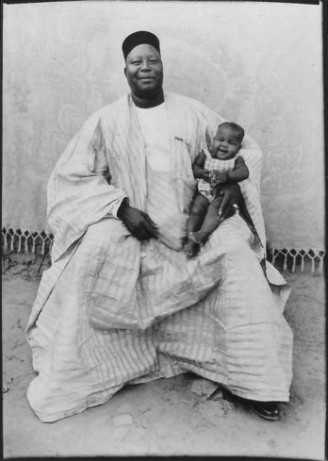
Seydou Keita, photography. (Bamako, 1951).
So, art then, is working to expose this history of suffering, in a sense, but of course it cannot do that by simply ‘depicting’ it, representing it, in images that are recognizable or in narratives with that message. It transcribes something — and that something is highly elusive and inherently necessarily fleeting. It cannot ‘just represent’ because the familiar is already compromised and a part of this history. The artwork must excavate by means unfamiliar, but nothing is completely unfamiliar — hence the negation and the dialectic. The familiar must be subjected to itself, in a sense. Nietzsche wrote “truths are illusions which we have forgotten are illusions, they are metaphors that have become worn out and have been drained of sensuous force, coins that have lost their embossing and now considered as metal and no longer coins.” Hence, as Adorno and Horkeheimer wrote, “all history is a forgetting”. Horkheimer, in an earlier work, wrote that civilization began with the mimetic but replaced it along the way with adaptation and domination. History as progress was forgetting what, in fact, children know also, and are coerced to forget. Or sublimate anyway. But adaptation *is* mimesis in a distorted form. A regressive form. As Martin Jay points out, the totalitarian leader, or the torturer, often imitate their victim. The ego is always in part an internalized version of authority — patriarchal authority in this history of the West. Hence the development of society is reflective of an ego that first sublimates authority and then imitates it, reproduces it, and in the interest of self preservation becomes acutely insecure. The defender of the status quo is always terrified.
The psychic trauma of adaptive coercive authority shapes today’s ideas of entertainment. Art is replaced, ad hoc, by entertainment in various registers. Entertainment is regressive mimesis, in the sense that exchange value is the form of the familiar, the sadistic puritanical narratives of subjugation and humiliation reproduce the creator’s own sense of terror and inferiority. A James Cameron, for example, is telling his own story of repressed inadequacy over and over. It is projected outward, of course, onto various *alien* objects, the better to distance it from himself. This is the familiar that accepts incompletion as a standard. (Netflix new neo-Colonialist film Beasts of No Nation would be a good example).

Mariko Mori (Dream Temple, 1999)
The artwork must adhere closely to the concrete, to be able to then leave it behind, in order to finally re-approach it again. The transcription of history is always both our own story, but told by the psycho-linguistic apparatus we have inherited. The staging of our Oedipul drama (or whichever version of this one prefers, as I don’t much care, honestly nor think it matters) takes place in one sense, in the theatre of our mind. That theatre is made in/by an inherited sense of space, of identity, and language — but that space is also itself auratic. Benjamin’s notion of the ‘aura’ is itself auratic, but it is useful to begin laying out something of this private stage in our mind. Except today its more like private movie palace, but more on that below. One way to look at this idea of private staging space for our mimetic narratives, and our psychoanalytic dream work, and daydreaming, et al…is to see it in light of this ruse of reason. The Hegelian regression. For one always pays rent. The theatre in your mind pays rent, too. And that is the, perhaps, deepest truth in all of this. The landlord of your private theatre is history, but history as myth, or it is Hegel’s identification-with-aggressor ticket stub. But this relates as well to what Catherine Malabou writes about Descartes’s notion of ‘passions of the soul’ and ‘passions in the soul’. The former belong to the soul, the latter are consequences, usually of the body in the most literal sense. But here are spatial models again, operating as a bit more than metaphor.

Codice of Farīd al-Dīn ʿAṭṭār, 12th century. Persian.
“Wonder is prior to judgment and will. Because it is nonjudgmental, wonder makes no hierarchy regarding what it wonders at. It is pure openness to the extraordinary. But, what is the extraordinary? On the one hand, the extraordinary seems to be alterity as such, everything that is not the soul and interrupts its self-identity. People who are indifferent to wonder and surprise are in that
sense locked in themselves, unable for this reason to perceive the uncanniness of the world.”
Catherine Malabou
The world of the corporation is one of anonymity. The world without wonder, a world that mimics all industrialized planning; much like the anonymous slaughter of WW1, achieved by technology and distance, in its intimate orders. As Enzo Traverso pointed out, the first air war, the first anonymous industrially planned war, and one in which both landscape, and the use of gas masks, created an depersonalized war.
There is no wonder in absence, or at least in this kind of absence. The corporate is the instrumental made into something that mimics collectivity, but not in space. Space is gone, and wonder is gone. Corporate logic is its own sort of myth, and the corporation is always about lack of access. Nobody can access what is above them. Nobody above wants to access what is below. Anonymity and distance. But when distance is surveyed by the anonymous and depersonalized, it ceases to be distance. The Nazi myth was one in which history is fixed, and liberation impossible because liberation meant change and nothing changes. Progress means looking backward, not forward.

Veronika Voss (1982). Rainer Werner Fassbinder, dr.
Dreams are really about stories, not images; but the stories are always entwined with what is bound up in the image. It is how language accesses images. And the rise of cinema as a sort of ever present source of both story and image today (in the west) and it is worth thinking about how films have changed how we narrate our dreams. For stories have largely in a majority of people in the West, I think, become cinematic stories. But what is the quality and nature of cinematic narrative in relationship to dreamwork, and to mimesis? Beginning with something related to space: darkness. Theatre is usually in the dark, but films are always in the dark. One of the things that makes television oddly different, or used to, is that darkness is not so important — but I suspect that really, any film or video, even those watched on a laptop outside in the daylight, are still taking place in the dark. For they take place in our private theatre, firstly. But if we narrate our dreams cinematically, then I think that means largely as montage. So dreams are revised by our conscious self according to the rules of montage, and one might ponder for example what The Wolf Man of Freud, as a silent movie would look like. The idea of montage changes ideas of duration. In narrative, in a 19th century narrating of dream, the patient development of images as one might find in Dickens, is replaced today with Tarantino like editing, or worse, simply the incoherence of Shonda Rhimes projects on TV. Does anyone, for example, really know what the fuck is going on in How To Get Away With Murder? The point is, that even if some do, it doesn’t matter. For the event, the gestalt ‘thing’ that is How to Get Away With Murder subsumes the actual story. Again, assuming there is one. Still, perhaps from another perspective, such shows as How to Get Away With Murder are more dream-like than plots of progression.
“Dreams partake of a non-logic, they are outside of any economy of usefulness. They are mysterious, shadowy, enigmatic. They appear fragmented, impalpable, elusive. They are like the theatre of the absurd, a one man show for only one spectator. They unfold in digressive and purposeless manner of conversation and with the disinterestedness of contemplation, wonder, and sensual aura. The dream is solitary, but still a dialogue with someone because at birth the self develops in a social dimension, before the unconscious becomes a linguistic unconscious and there is a glimmer of self awareness.”
Giuseppe Civitarese

Ruud Van Empel, photography.
The endless exposure to kitsch melodrama and cop shows, which are called hour drama but run for about 42 minutes has clearly had a collective effect. But this kitsch form which is now so stultifying in its familiarity, is also one which has conditioned people to dream in segments I suspect, and with anticipated interruptions. But this is a pretty reductive take on this, and I think the more seriously one explores the mimetic in relationship to this Hegelian logic of domination, and its imposition on, for example, even montage, the implications begin to spin outwards in infinite circles of meaning.
I have always wondered at the background area in dream images. I actually can’t find any writing specifically on this subject, but my own experience is that the background area in dreams has been shaped, for Westerners like myself, with a Renaissance horizon, but dark, and even when the dream is in daylight, or during the day, the deeper truth is that it is always night in dreams. Italian pyschiatrist Giuseppe Civitarese, quotes St. John of the Cross to the effect that the closer the soul comes to God, the more apparent the darkness all around. Our background areas are in a sense what you see in many Renaissance portraits, but all the way through Rembrandt, certain skies and areas, woods and forests, meadows, are obscured, in a kind of artificial darkness. The clarity is what one sees through the windows — the Euclidean horizon, not the reverential space of the supplicant soul. In Biblical subjects, the painters of the 14th and 15th and on into the 16th century, nearly always injected a quality of the hallucinatory to their very narrative paintings. This is a link to that idea of that the Enlightenment changed profoundly how humans *saw* the world, and represented it. Donatello’s famous sculpture of the prophet Habakkuk, is a work I cannot see being made in the 19th century, or rather, the emotion, the feeling of that work doesn’t exist by then, not in the same way. When I first saw south Indian classical dance, I was struck by the kind of religious eroticism it expressed, an intoxication, of a kind that has no parallel in Christianity.
Mimesis is how John Berger writes of Rembrandt;
“On canvas after canvas he gave to a part of a body or to parts of bodies a special power of narration. The painting then speaks with several voices—like a story being told by different people from different points of view. Yet these “points of view” can exist only in a corporeal space which is incompatible with territorial or architectural space. Corporeal space is continually changing its measures and focal centers, according to circumstances. It measures by waves, not meters. Hence its necessary dislocations of “real” space… Before his art, the spectator’s body remembers its own inner experience.”
But it is also what one takes away from Donatello’s statue of The Prophet, where the spectator remembers another realm, an elsewhere, a kind of clairvoyance, a second sight. This is the archaic. For once mimesis is intentional and organized, a doubling occurs. That is tied to revision, the secondary dream revisions. Habakkuk is like all prophets, his magic is mimesis in the future – it is a denial of the contiguous. The viewer’s body remembers what it is impossible to remember.
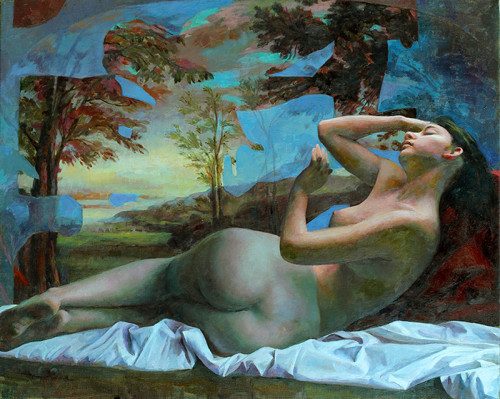
Dan Ludwig
“To spend enough time with the work is to incur a trance of anticipating the words that are forever on the tip of the figure’s tongue. They are apt to be important, in the way of an apocalyptic prophesy…”
Peter Schjeldahl
On Donatello’s The Prophet Habakkuk
The trivializing quality of advanced Capitalism has encroached now on our dream life. What one feels in the artworks of earlier eras is something akin to what Civitarese calls the ‘necessary dream’, that sense of another world or realm that is opened to us. The realm where things make dream-sense, but do not have real logical meaning. Of course, they also have meaning, for they do more than one thing. The very idea of nightmare is interesting in this respect; for the nightmare is some form of challenge to this distant haunting world. The challenge is also usually something being worked out that is unacceptable from our waking lives. Have nightmares changed? No doubt. The secular sense of a heightened reality that is only accessed in dreams has become colonized somewhat. So deep is this Hegelian ruse of reason, so deep is the form of exchange value, the sacrificial part of it, that our conscious self increasingly rejects the darkness and shadows. An element of the popularity of cinema resides in the darkness of the theatre. And there is a betrayal in how brutally marketing and capital have ursurped film language and turned it into a kind of attack on the dream life of cinema. And by extension on all art. And part of this Enlightenment legacy is found in the privileging of light over darkness. Darkness is backward and ignorant, and of course the optical politics of colonialism is evident in this, too.

Boris Mikhailov, photography.
“Psychoanalysis is the expression of critical thinking that places at its center the metaphor of Oedipal blindness as a prelude to insight or vision. Accordingly, the paradigm of the psychoanalytic method is the dream, both divine and ghostly, evanescent and as sensorially intense as hallucination.”
Giuseppe Civitarese
There is something else, though, in a loss of deep dreaming, and that is the narrative. The telling of the dream. Almost every serious examination of Freud arrives at the sixth chapter of The Interpretation of Dreams. This is the breakdown of dreamwork — and it is where metaphor and allegory and metonymy loom as that stone cold floor of how humans make ‘meaning’. In dreams, the historical shaping of the psyche will remove certain things, exile images or even words. The psychic censor is historically determined, and this is at both a personal and a societal/historical level. This is why Adorno was so insistent on the dialectical nature of myth; that everything then exists fluidly, and this is why repetition and obsession are inseparable from repression. The importance of aesthetics (and mimesis) is in looking to express the inexpressible. The colonized consciousness is being coerced to ‘not’see, ‘not’ hear, and, more importantly I think, to embrace and endorse the very most fraudulent artworks. Kitsch is a historical revenge on emancipation, or on the potential for the emancipatory.

Rembrandt. “The Rape of Ganymede” 1635.
“Production thus creates the consumer. Production not only furnishes the object of a need, but it also furnishes the need for an object.”
Marx (Grundrisse)
Technology has accelerated its coercive nature over the last thirty years. The structure of privilege has solidified, and the most effective expression of coercion is now the highjacking of the unconscious, or at least I would argue, the shaping of this archaic staging area. And part of how this has happened has to do with control of the temporal, maybe more than the spatial. The politics of optics; the over illumination of western homes, the admonishment to keep your eyes open. Don’t fall asleep. Keep an eye out…for what? For how long? Sleep has never been so dismissed and medicalized, even pathologized as today. Sleep disorders have to do with, usually, not being able to fall asleep — but the real problem is to wake up. If you don’t sleep, you can’t wake. But over illumination is also, additionally, an aspect of Pantopticon control. The spotlight, the police searchlight, etc.
The very development of the reliance on screens is amazing. People no longer trust signage that isn’t electronic, that isn’t digital. Sleep and blindness intersect in narrative, and in metaphor, and metonymy. ‘Murdered sleep’ cries Macbeth, and it is Borges who Civitarese quotes about his blindness, about the numinous mist, and Lacan sensed early the importance of the ‘blind spot’ and its resonance as metaphor and as literal biological condition. Anatomical condition. Werner Herzog said in an interview that Americans were insane to need every corner of their homes illuminated. That if everything were lit, if all shadows removed, we would go insane.
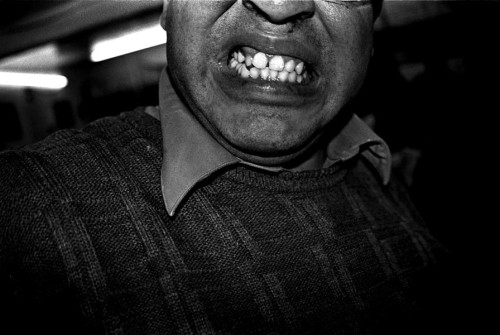
Jose Luis Cuevas, photography.
Our archaic selves, our pre-linguistic memory is of place. Of habitation. When one remembers something, a party or a holiday, the adult will still remember first ‘where’ it happened. But then the when and the concept, as it were, of what happened. And even that, the idea of ‘happened’ is fraught with ideological baggage. Memory, as it surfaces, is an inhabited landscape. Odors are the strongest trigger for memory. A certain aroma can remind me of a place I was, years ago. In my youth. What is it I am remembering? I remember the place. A place that only exists in a past-time. It is inhabited by shades, or spectral figures of pastness. In theatre, I have personally never liked entrances or exits. It feels as if the play is reminding the audience that this is a play. It is disruptive of memory. It draws attention to something outside of the dream. Outside the auratic actor, as it were. The Greeks sent messengers running on stage with important information. In films today, increasingly, drastically, stories are tied up with cell phones. With texting. The characters now must define location with not just GPS, but with a conversation or text that establishes, yes, correct, I AM HERE. See, look at the screen. The audience only knows location because they are told the screen of the cell phone has verified it. As a side note; one of the most popular plot devices in crime shows on TV now is the subterfuge of putting CCTV images on a recorded loop — so the security guards are left watching a loop where nothing changes, while in reality a crime is taking place. The metaphor here is amusingly obvious, a society watching nothing on an endless loop. Anyway — when I remember a place, from the past, triggered by an aroma or odor, that concept of remembrance, that action, is also a kind of reification, or forgetting. So remembering is also forgetting, simultaneously. This is how language intersects. Nietzsche said “every concept arises from the equation of unequal things.” This is what Adorno meant by language embedding social logic, embedding exchange value. And it is this which is so insidious. This quickly becomes the topic of non-identity, but for the purposes here the Hegelian ruse, the structure of experience that becomes articulated in a language of exchange value, has aesthetic importance.
In Dialectic of Enlightenment, Adorno and Horkheimer use the Odyssey as the “primal history of subjectivity”. The point here is that the logic or structure of sacrifice is a form of self sacrifice, and this is linked to repetition, a repetition of the same. That anthropology has a distinct colonial origin, and method, the entire idea of a ‘field’ of study is probably linked, as Edward Casey suggests, to property and possession, too. Mastery is implied throughout. The subject is reduced to an imitation, or duplication of abstract nature, lifeless and self-isolated. The self sacrifice is exchange value, and it passes in stealth mode, and if the ‘field’ of study is a living metaphor, then spread before the master is a space to worked upon. Exchange value.

Matthew Wylie, photography.
“Theory, which, when it is theory, is a longing for the right thing that presents the weight of history in constellations of concepts as the capacity to distinguish what might be from what is, as right wishing—instead became ―theory, a generic object. It seems to have had no choice but to pursue a logic of equality conceived as interchangeability.”
Robert Hullot-Kentor
In theatre the enigma of acting remains so opaque exactly because it appears to be nothing at all. How is it different from daily life exactly? One speaks of a ‘performance’ because a performance implies an ending. But as Adorno knew, all reconciliation in Enlightenment terms is a false reconciliation. The actor is doing what? Well, in film the actor is photographed. The actor is before a camera, and that is an entire discussion onto itself, but on stage, in live theatre, the actor is speaking someone else. The recitation is of one missing. The bows at the end of a ‘performance’ are a strange ritual of acknowledgement; of applause (and THAT is another topic) but also an acknowledgement of immanent departure. The actor bows and leaves. He or she walks off stage. The actor is exiled. There are implications in this that are tied to the recitation of memorized lines of dialogue, but also to sacrifice. But ‘this’ sacrifice is not exchange value because the value of the actor is not instrumental, it is archaic.

Ettore Spalletti, (Angelo astuto, 2003. Photo: Jörg Hejkal).
Allow me a longer quote from Robert Hullot-Kentor, from an essay he wrote after 9/11 in which a critique of the marketed spectacle of sentimentalized suffering is analysed in some depth:
“Who wouldn‘t want to know exactly ―how much American audiences can stomach? When does the ratio of solemn occasion to business
opportunity become intolerable? If the answer were not in the puzzle there would be nothing to solve. The clue given is in the whiff of sacrilege at the perceived corruption of a solemn occasion by a business opportunity. It indicates the underlying primitive landscape. What transpires on this terrain becomes evident in the recognition that the solemn occasion and the business opportunity are by no means mutually extrinsic, as if a tincture of one immediately debases the other. For the piety of every solemn occasion to date—every holiday—revolves around an act of sacrifice that proceeds with the same substitutional cunning as does the studied solemnity inherent in every business transaction. What once occurred in ancient Greece at an altar stone to which an unblemished white ox had been led; where it
was made to bow and raise its head in following the movement of a basket of feed lowered and raised under its nostrils; the pious affirmation affirmation completed in the slash of the blade under its throat; the terrifying and arousing scream of the women masking the sound of the animal‘s groan; the men sharing in the blessing of the propitiatory splash of blood in substitution for the penalty demanded by their own guilt; the carcass split out over the flames guarded by the priests; the inadequacy of the sacrifice that always demands the next sacrifice now occurs across a countertop in the silence of the systemimmanent equality of exchange, in the however sublimated splash of coin and appropriated profit, while, in following the movement of groceries across the bar-code scanner, someone is being cheated.”

Alexander Tinei
The secret theatre of the self, as Joyce McDougall calls it, is actually an historical theatre, and one operated by forces not just of our individual past, our childhood psychic formation, but also the forces of post industrial Capitalism and western Imperialism. The adaptation to a role learned in childhood is really a coerced adaptation, and more pernicious is the script having been written by a total system of exploitation and sadism, of domination and class hierarchies. This is an increasingly uncanny mental theatre. The daily life of a populace that is under enormous duress is both theatre and film; the fungible characters in contemporary daily life are of course only perceptually fungible — but that is reification. I suspect the reification of daily life has reached a stage (sic) in which the sense of emotional disconnect could justifiably be called insanity. A majority of Americans admit they can’t follow the news reports with any grasp of details, and that same majority believe in Angels and have trouble finding the Pacific Ocean on a map. But they are adroit in texting and operating cell phone technology. This level of disconnect, emotionally, is functional in a highly racist and punitive culture today where advertising and entertainment reinforce the validity of punishment as a solution for most conflict and stress. The rise of severe narcissistic disorders in the bourgeoisie today means that finding even substitute gratifications is more and more difficult. And that results in what McDougall calls the new ‘delusion’ of today’s culture. Mass delusion in which the plots in this private theatre of the mind are now psychotic. The sense of not having the right to exist. Or more often, for others not having the right to exist. But let me take this back to dreams for a moment. And in particular how meaning is arrived at in dreams. As Samuel Weber says, Freud wanted to sort of reverse engineer how meaning was arrived at in the unconscious. In dreams. Again, in that most significant chapter six of The Interpretation of Dreams; Freud in an appended note made clear that dream work created the form, a form of thinking. All mental phenomena have meaning, but the meaning is often not the essence. He said it was not the content but rather the form that the dreamwork imposes that has greater significance. This is not terribly far from what Adorno saw in his aesthetic interpretation. Weber says “the dream is not motivated by the goal of representing but rather…by *de-presenting*”. Dreams employ images, but the language of the unconscious, the language of language if you like, is historical. The visual syntax is firstly historically determined, and then the dream work uses condensation, displacement, representability, and secondary representation. The law of identity is suspended in dreams. Or at least tactically employed. Dream work also dissimulates its own distortions. Now Adorno believed that pathological states helped magnify the coercive aspect of the Ego. In other words, the un-free character of the everyday is manifest in compulsions and obsessions and repetition. The unity of the self at its core is coercive. Society is coercive.
“With lacquerware there is an extra beauty in that moment between removing the lid and lifting the bowl to the mouth, when one gazes at the still, silent liquid in the dark depths of the bowl, its colour hardly differing from that of the bowl itself. What lies within the darkness one cannot distinguish, but the palm senses the gentle movements of the liquid, vapour rises from within, forming droplets on the rim, and the fragrance carried upon the vapour brings a delicate anticipation … a moment of mystery, it might almost be called, a moment of trance.”
Jun’ichirō Tanizaki, In Praise of Shadows

Byung-Hun Min, photography.
To return to aesthetics then, the mimetic is at work in the internalizations of melancholia. Justin Whitebook’s essay on Adorno and Freud points out how often the bereaved will take on mannerisms and qualities of the deceased. The process of internalizing becomes a building technique of psychic structures, of all mental life. The inner realm of the object. Freud even said (quoted by Whitebook)…“the shadow of the object falls across the ego.” The artwork is then, as I’ve noted before, always a failure. Its meaningfulness is always in its reach and failure. The impossible in art is art. There is an aspect, too, of the forbidden in creativity. And with the forbidden, too, comes mourning. Freud wrote that dreams end in darkness. Political optics perhaps. The artwork must give voice to what ideology hides. The U.S. has never really trusted the idea of art. For Americans, the idea of art after Auschwitz was closer to will there be a tenth season of Breaking Bad after Auschwitz. Art may or may not be seen in some fashion to humanize the public, but historically in the U.S. the question was given only token consideration. The United States loves soldiers, astronauts, and businessmen. And they don’t really love them anyway, they are too anxious and fearful for love. But in some way the public does validate these models. And increasingly there is a class split in perception; the white educated classes are entrenched in MFA programs, and most criticism (if not almost all) comes from academia. The average citizen has internalized the form of sacrifice, of exchange value, even if only unconsciously, and hence despite ambivalence will project outward various forms of sacrifical justification. The poor are poor because they deserve it, sure, but also they ‘aughta just sacrifice’, and quit being so selfish. Millionaires can be selfish. That is ok. The poor must sacrifice. Art is not a consideration. Entertainment is, and its willingly accepted as business. One of the qualities in contemporary film and TV from Hollywood is that dialogue is never obscure. Stories can make no logical sense, but dialogue is never less than clear and simple. There is an absolute ban on poetics of speech. But, that is perhaps a quite big topic, really, for film and TV are visual mediums and language is never really foregrounded. Hullot-Kentor says of Adorno’s Aesthetic Theory…
“..at this moment, Aesthetic Theory could give us a basis on which to figure out in what way taste can be disputed and the correlative impulse to develop an exactitude in listening…”. That is it really, an exactitude in taste. Not promoting that which agrees with us, or even that which gives pleasure, per se. But that which is exact. For exactitude means starting to dismantle the structures of exchange value and sacrifice.
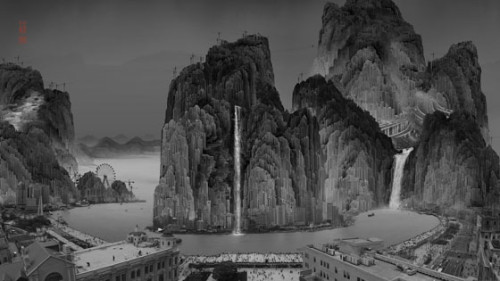
Yang Yongliang
Mysticism
“The sun can only be seen by the light
of the sun. The more a man or woman knows,
the greater the bewilderment, the closer
to the sun the more dazzled, until a point
is reached where one no longer is.
A mystic knows without knowledge, without
intuition or information, without contemplation
or description or revelation. Mystics
are not themselves. They do not exist
in selves. They move as they are moved,
talk as words come, see with sight
that enters their eyes. I met a woman
once and asked her where love had led her.
“Fool, there’s no destination to arrive at.
Loved one and lover and love are infinite.”
Farid ud-Din Attar (tr.Coleman Barks)
The Conference of the Birds

the adorno/horkheimer quote: “Man’s domination over himself, which grounds his selfhood, is almost always the destruction of the subject in whose service it is undertaken.” …I am wondering, what they mean by “almost always”–in other words, what is happening in those situations of self domination under which the subject is not destroyed….?
And, further, how do we know who the subject is, when they refer to “the subject in whose service it is undertaken”…? Or can we entirely know? Can it be more than one “subject”? –Maybe these questions aren’t relevant because I’m not well-informed enough about the original context of this quote. If so, please disregard.
I’m still trying to get a better sense of the nuances of your meaning of ‘mimesis.’ I’m wondering, is it possible for mimesis to be a form of domination, or is that something else (like mimicry, perhaps)? The way I understand mimesis, is that it cannot be used as a form of domination, in part, because it is the practice of moving outwards and moving inwards at the same time; it is a “shared” form, not a dominating one. SO, relating to the above quote, could one “dominate” one’s self through mimesis as a form of, paradoxically, “shedding” domination over one’s “self” or “subject”?
@calla………..
Mimesis, at least as Adorno used the term, is one of the more contested concepts in his entire body of work, Id say. So a short answer is very hard. Hullot Kentor called it that private karaoke in your head. Mimicry is sort of a precursor to mimesis in this context. A&H saw archaic mimicry as an offshoot of self preservation. An adaptation to nature. Gebauer wrote “the goal of this adaptation in human beings was to escape the terrors of nature which represented a threat to the gradually developing self…the fear of transforming back into nature ‘from which it had estranged itself with so huge an effort and which therefore struck such terror into the self’ leads to an adaptation to death.” So protection as fear is a kind of mimicry. This is the stiffening or numbness of archaic schemata (per A&H) of the urge to survive…..but this is the very early stages of humanity. It is both submission to nature and in intention, an overcoming. Frederic schwartz book Blind Spots is very good on the later evolution of this idea as its found in Adorno. The domination aspect, over nature becomes too a domination over inner nature. The self is sort of constituted through its intention to dominate, self objectifies, and this is where the subject falls prey to its own will to dominate. Its all part of this split between mind and body, intutition or instinct and rationality leading to isolation — and rationality, abstraction, coming out of the subject eventually reifies all human relationships. This is linked to disenchantment, and a resulting self sacrifice. And much of this is too painful and hence repressed, made into a taboo. Much of the role of art, then, is an attempt to reclaim what has been surrendered…and lost or forgotten. Of course the historical/social is linked intimately with all this, the enlightenment, capitalism, etc. And with language and how we narrate this to ourselves.
@ Steppling,
thanks…..I think I’ve got a good grasp of what you are saying in the later part of your response, but I’m being thrown off a bit by the Gebauer quote…. So is “adaptation” as he is using the term, akin to mimicry or mimesis? And, maybe I’m taking for granted that I am using terms in the same way you are. What do you mean by “nature”?
And when you describe that “private karaoke in your head,” it sounds to me as though mimesis is a kind of narrative. I am wondering, what is the difference between narrative and mimesis?
The reason I am so interested in mimesis right now, is not simply because you use the term frequently in your posts, but because I have come across it a lot in my readings lately. I am interested in mimesis in the context of reading/writing poetry (metaphor, language use), and also in what theatre actors do with their bodies.
I suspect one of the reasons I am having a bit of trouble wrapping my head around some of these ideas is because my concept of what “subjectivity” means, is currently under scaffolding, undergoing major renovations……restorations(?) So, when the word “subject” is used, I have to mentally shuffle back-and-forth between a couple different models I have for that term….none of them fully functional.